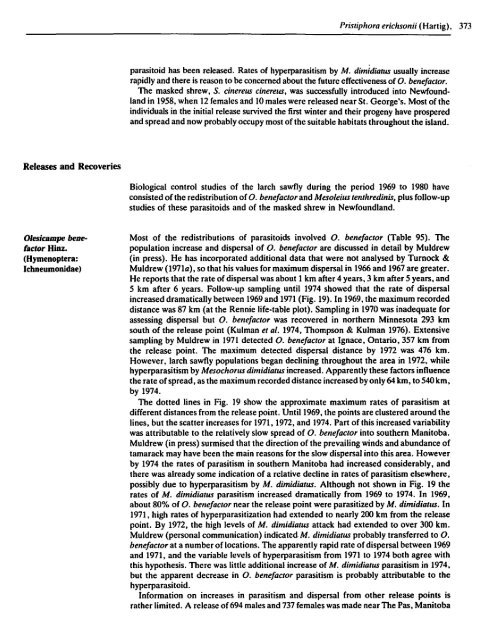pdf, 57.71Mb - Entomological Society of Canada
pdf, 57.71Mb - Entomological Society of Canada
pdf, 57.71Mb - Entomological Society of Canada
You also want an ePaper? Increase the reach of your titles
YUMPU automatically turns print PDFs into web optimized ePapers that Google loves.
Releases and Recoveries<br />
Olesicampe benefactor<br />
Hinz.<br />
(Hymenoptera:<br />
Ichneumonidae)<br />
Pri.slip/lOra erichsonii (Hartig), 373<br />
parasitoid has been released. Rates <strong>of</strong> hyperparasitism by M. dimidiatus usually increase<br />
rapidly and there is reason to be concerned about the future effectiveness <strong>of</strong> O. benefactor.<br />
The masked shrew, S. cinereus cinereus, was successfully introduced into Newfoundland<br />
in 1958, when 12 females and 10 males were released near St. George's. Most <strong>of</strong> the<br />
individuals in the initial release survived the first winter and their progeny have prospered<br />
and spread and now probably occupy most <strong>of</strong> the suitable habitats throughout the island.<br />
Biological control studies <strong>of</strong> the larch sawfly during the period 1969 to 1980 have<br />
consisted <strong>of</strong> the redistribution <strong>of</strong> O. benefactor and Mesoleius tenthredinis, plus follow-up<br />
studies <strong>of</strong> these parasitoids and <strong>of</strong> the masked shrew in Newfoundland.<br />
Most <strong>of</strong> the redistributions <strong>of</strong> parasitoids involved O. benefactor (Table 95). The<br />
population increase and dispersal <strong>of</strong> O. benefactor are discussed in detail by Muldrew<br />
(in press). He has incorporated additional data that were not analysed by Turnock &<br />
Muldrew (1971a), so that his values for maximum dispersal in 1966 and 1967 are greater.<br />
He reports that the rate <strong>of</strong> dispersal was about 1 km after 4 years, 3 km after 5 years, and<br />
5 km after 6 years. Follow-up sampling until 1974 showed that the rate <strong>of</strong> dispersal<br />
increased dramatically between 1969 and 1971 (Fig. 19). In 1969. the maximum recorded<br />
distance was 87 km (at the Rennie life-table plot). Sampling in 1970 was inadequate for<br />
assessing dispersal but O. benefactor was recovered in northern Minnesota 293 km<br />
south <strong>of</strong> the release point (Kulman et al. 1974, Thompson & Kulman 1976). Extensive<br />
sampling by Muldrew in 1971 detected O. benefactor at Ignace, Ontario, 357 km from<br />
the release point. The maximum detected dispersal distance by 1972 was 476 km.<br />
However, larch sawfly populations began declining throughout the area in 1972, while<br />
hyperparasitism by Mesochorus dimidiatus increased. Apparently these factors influence<br />
the rate <strong>of</strong> spread, as the maximum recorded distance increased by only 64 km, to 540 km,<br />
by 1974.<br />
The dotted lines in Fig. 19 show the approximate maximum rates <strong>of</strong> parasitism at<br />
different distances from the release point. Until 1969 , the points are clustered around the<br />
lines, but the scatter increases for 1971, 1972, and 1974. Part <strong>of</strong> this increased variability<br />
was attributable to the relatively slow spread <strong>of</strong> O. benefactor into southern Manitoba.<br />
Muldrew (in press) surmised that the direction <strong>of</strong> the prevailing winds and abundance <strong>of</strong><br />
tamarack may have been the main reasons for the slow dispersal into this area. However<br />
by 1974 the rates <strong>of</strong> parasitism in southern Manitoba had increased considerably, and<br />
there was already some indication <strong>of</strong> a relative decline in rates <strong>of</strong> parasitism elsewhere,<br />
possibly due to hyperparasitism by M. dimidiatus. Although not shown in Fig. 19 the<br />
rates <strong>of</strong> M. dimidiatus parasitism increased dramatically from 1969 to 1974. In 1969,<br />
about 80% <strong>of</strong> O. benefactor near the release point were parasitized by M. dimidiatus. In<br />
1971, high rates <strong>of</strong> hyperparasitization had extended to nearly 200 km from the release<br />
point. By 1972, the high levels <strong>of</strong> M. dimidiatus attack had extended to over 300 km.<br />
Muldrew (personal communication) indicatedM. dimidiatus probably transferred to O.<br />
benefactor at a number <strong>of</strong> locations. The apparently rapid rate <strong>of</strong> dispersal between 1969<br />
and 1971, and the variable levels <strong>of</strong> hyperparasitism from 1971 to 1974 both agree with<br />
this hypothesis. There was little additional increase <strong>of</strong> M. dimidiatus parasitism in 1974,<br />
but the apparent decrease in O. benefactor parasitism is probably attributable to the<br />
hyperparasitoid.<br />
Information on increases in parasitism and dispersal from other release points is<br />
rather limited. A release <strong>of</strong> 694 males and 737 females was made near The Pas, Manitoba
















